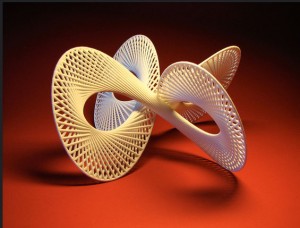By Simon Fischweicher Bard MBA ’16
The movie “Wall-E” portrays a dystopian future in which humanity has abandoned an Earth covered in skyscrapers of waste.
Sci-Fi cartoon? Yes. A plausible vision of the future? Maybe.
Society’s waste puts our planet’s ecosystems and natural cycles at risk. Plastic waste is especially bad as it can take up to 1,000 years to decompose. Less than 10 percent is recycled. Creating new, raw plastic is fossil fuel intensive and environmentally taxing. Is the only answer to abandon the planet to Wall-E?
Maybe not. 3-D printing could offer a dual solution, allowing transformation of plastic waste into new plastic products.
3-D printing can revolutionize where products are produced and how they look. It could lead to more local production and greater efficiency of design. Designers can scan a person’s jaw or use computer software todesign a chair using the biological structure of a leaf. They hit go and their item is “printed” into existence. 3-D printers generate less waste since they use additive manufacturing rather than injection-molding — or milling, where products are cut away from larger pieces.
3-D printing is nota green panacea, as a study by the University of California, Berkeley’s mechanical engineering department found. It is still limited in capability, it’s costly and most 3-D printers are more energy intensive than other manufacturing methods. Furthermore, certain 3-D printers and filaments — the thermoplastic polymers melted into form by the printer — create significant waste, as well as toxic fumes. Inkjet 3-D printers, which use deposits of hot liquid material to bind a bed of powder, create a significant amount waste. Additionally, scientists from the Illinois Institute of Technology and the National Institute of Applied Sciences in France studied emissions and toxicity of 3-D printing materials: They found that certain materials like Acrylonitrile butadiene styrene (ABS) filament, resulted in toxic fumes dangerous to humans.
Appropriately employed, however, 3-D printing plastic waste could help create more sustainable manufacturing. Answers to the challenges are emerging: 3-D printers that utilize Fused Deposition Modeling or FDM methods — imagine shapes formed by hot glue gun that deposits layers of liquid plastic — do not create waste. Methods using Polylactic Acid (PLA) filaments were nontoxic and had no health risks. 3-D printing still has limitations, but, using FDM printers and PLA filaments, waste and toxicity can be eliminated.
Nowhere is this more evident than in the developing world: It is estimated that there are around 15 million waste pickers globally. These individuals collect, sort and sell recyclables to make a living. In India, the social enterprise Protoprint is empowering urban waste pickers to produce 3-D printer filament themselves from the plastic waste they collect. Protoprint collects the filament and sells it to customers, who are glad to purchase a recycled substitute to new plastic filament.
Other 3-D printing enthusiasts have gone a step further, creating small-scale 3-D printers that can actually melt plastic waste and print it into products like water collectors, plastic tools and small rafts. Researchers at Michigan Technological University created the Recyclebot, which uses the RepRap self-replicating 3-D printer to turn plastic waste into plastic filament and then directly into the end product. Combine this innovation with aportable, solar-powered 3-D printer, also tested at Michigan Tech, and you’ve got a self-sufficient production tool that could generate economic prosperity throughout the developing world.
Application of these practices will not be limited to waste pickers in the developing world, however. Plastic waste, unemployment and demand for goods are important issues in the developed world as well. Local recycling and waste centers could purchase 3-D printers and double as production hubs. Imagine a one-stop shop where you can drop off recycling and design and print a new iPhone case. 3D Systems, a publicly-traded company, has already released personal, high-quality 3-D printers like the Cube 3 that use 25 percent recycled plastic filament. At present, you purchase the filament from the company. However, as the technology improves, 3-D printers should allow users to use their own plastic waste to make new water bottles, containers, toys, tools and parts at home or in the office.
In the not distant future, imagine a world where nothing is wasted: Excess food is composted or fed to livestock; metal parts are smelted and reused; paper, glass and plastic are recycled. And, any additional plastic waste is sold to local 3-D printing shops or used in personal 3-D printers at home or in the office to make new containers, tools, parts, furniture or whatever is needed. It’s not too late to save the planet from becoming Wall-E’s graveyard of wasted plastic.
